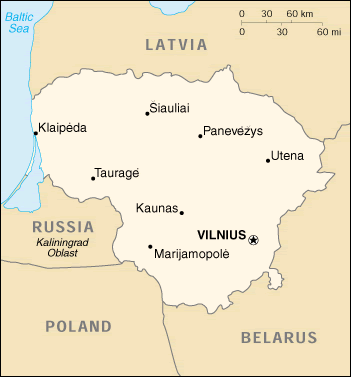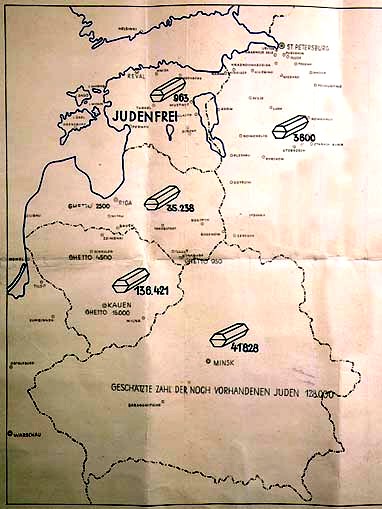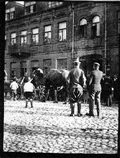KOVNO HISTORY
Kaunas (Lithuanian) Kovna, Kovne, Kauen, ...
The WELLER’s came from Kovno (now Kaunas) and the ZEMSER’s from Vilna (now Vilnius). Both places are currently in Lithuania although in the past, they were in the Russian or Polish Empires, depending upon political boundaries of the time. Historically, Kovno is known as the second city of Lithuania and was its capital from 1918-1940. Under Czarist Russian rule, it was the provincial capital and administrative seat for much of central Lithuania, then known as Kovno Guberniya.
Location: At the confluence of the Neiman (Nemunas) and Neris rivers, 100 km west of Vilna (Vilnius).

History of the Jews in Kovno
1410 - 1782
Jews are first known to have lived in Kovno as early as 1410 when they were brought there forcibly as prisoners of war by the Grand Duke Vytautas. Many of those Jews were later active as traders between Kovno and Danzig (today's Gdansk, Poland). Living conditions for many Jews were squalid.
Jews were engaged in trade in Kaunas in the 16th century, but due to opposition from Christian merchants, they were prohibited from the city on numerous occasions. The ban existed until the 18th century when Jews were permitted to settle on two streets in Kaunas and to engage in trade. They were expelled again in 1753 and 1761 when there were anti-Jewish riots. The Jews found refuge in Slobodka, on the other side of the Viliya River, where a Jewish settlement had existed long before that of Kaunas. In 1782 the expelled Jews were permitted to return to Kaunas.
1795-1918
After the partition of Poland in 1795, Kaunas became part of the Russian Empire. In 1847 there were 2,013 Jews living in Kaunas and Slobodka; 16,540 in 1864; 25,441 in 1897 (30% of the population); and 32,628 in 1908 (40% of the population). In 1858, archaic living restrictions were relaxed and all but 6,000 of the city's 35,000 Jews flocked to the Old Town in search of something better. In the second half of the 19th century, Kaunas became a center of Jewish cultural activity in Lithuania.
In May 1915 an edict was issued by the czarist government expelling the Jews from the entire province. When the city was later occupied by the Germans, about 9000 Jews returned, and communal life was revived with the help of Jews in Germany. After WWI, Kovno became part of Lithuania.
WWII
During WWII, after the outbreak of the German Soviet war and even before the Germans occupied Kaunas (June 24, 1941) Jews were killed there by Lithuanian Fascists. Immediately after the German occupation, large scale anti-Jewish pogroms took place affecting some 35,000 Jews. The Jews in both Slobodka and Kaunas were moved into the ghettos.
The first pogrom was on June 25, 1941. In July 1941, the Nazis expelled all the Jews from the town and sent them back to Slobodka. The Kovno Ghetto was thus established. On 7 July 1941, Avraham Tory (no relation!) noted in his Kovno Ghetto Diary: "Soviet rule has disappeared. The Jews are left behind as fair game; hunting them is not unprofitable, because the houses and courtyards of many of them brim with riches. 'Slaughter the Jews and take their property' - this was the first slogan of the restored Lithuanian rule..." By October, some 1,800 people were consigned to their deaths in a smaller Ghetto.
By the end of 1941, the Jewish underground, operating in the ghetto numbered 800 members. They began sending people into the forests to join the partisan resistance against the Germans. Through lack of experience and the hostility of the local population, many members of the underground were killed or captured.
Like other Ghettos, not all the days were tragic. There were moments of joy betwixt long days of false hope, delivered with fresh supplies of food or bundles of firewood. Avraham Tory wrote in his diary that some cultural events were remarkably maintained such as a Purim festival and a Passover celebration. The Ghetto also organized a symphony orchestra, lectures, art classes, discussions and Yiddish classes for children. Maintaining even a semblance of Jewish life and tradition was as great a statement of resistance as picking up a gun. But that resistance only lasted so long.
Chiune Sugihara, the Japanese diplomat in Kaunas (1939-40) was personally responsible for issuing 6,000 visas for safe passage out of Lithuania to Japan.
IX Fortas
Kaunas' darkest side is IX Fortas, one of a series of forts built by the Russians but later used by the Nazis as a murder factory. Located in Kaunas' northwest outskirts, the fort failed the Russians in their attempt to defend their western frontier, falling to the Germans in only eleven days of battle. Inside, primitive bedding remains firmly behind double meshed bars covering the windows of the cells. The prison's fortified walls exude a stale coldness, creating an appropriate somber mood for viewing the numerous displays of photographs and reports of the gruesome events which took place here. In addition to the communal cells was the "Health Room," a 3 meter by 1 meter hole beneath a stairwell, and the "Wet Room," a fairly spacious but dank chamber of concrete without a crack of light.
For those held captive in the IX Fortas, it was a short shuffle from the front gate down the Path of Death to the Wall of Death, a corner of a moat-like trench where people were lined up as targets and shot. Today, this wall is still riddled with bullet holes and is the fort's starkest reminder of the evil that was perpetrated here. In all, some 80,000 people from Lithuania, Austria, France, and other Nazi occupied areas, were slaughtered at the fort, including most of Kovno's population. Just behind the trench is a field where the dead were discarded. Today, it is a peaceful spread of green back-dropped by a new housing development.
Ghetto Liquidation
When the Soviet attack began in July, 1944, the Germans liquidated the Kaunas ghetto and concentration camps in the area, using grenades and explosives to kill the Jews. In this action, some 8000 Jews and others were sent to Germany. The men were sent to Dachau and the women to Stutthof. Over 80% of them died in these camps before liberation.
Kaunas was taken by Soviet forces on August 1, 1944. Most of the Jewish survivors did not return to Lithuania. Many settled in Israel.
At the corner of Ariogalos and Linkuvos streets in the Vilijampole district of Kaunas, Lithuania stands a simple, lone granite memorial to those Jews who perished at the hands of the Nazis in World War II. It stands like a lone sentinel, keeping a 24-hour watch over the souls of the dead. Quietly but determinedly, it commands us to heed its eternal message of remembrance. It was here in this suburban district known to the Jews as Slobodka that on German orders, the Kovno Ghetto was sealed on August 15, 1941 with 29,000 impounded people. The area had been a Jewish village for four hundred years.
The Kovno Ghetto - 1941-1944
Between July and August 15, 1941, the Germans concentrated the remaining Jews, some 29,000 people, in a ghetto established in Slobodka. It was an area of small primitive houses and no running water. The ghetto had two parts, called the "small" and "large" ghetto, separated by Paneriu Street. Each ghetto was enclosed by barbed wire and closely guarded. Both were overcrowded, with each person allocated less than ten square feet of living space. The Germans continually reduced the ghetto's size, forcing Jews to relocate several times. The Germans destroyed the small ghetto on October 4, 1941, and killed almost all of its inhabitants at the Ninth Fort. Later that same month, on October 29, 1941, the Germans staged what became known as the "Great Action." In a single day, they shot 9,200 Jews at the Ninth Fort.
The ghetto in Kovno provided forced labor for the German military. Jews were employed primarily as forced laborers at various sites outside the ghetto, especially in the construction of a military airbase in Aleksotas. The Jewish council (Aeltestenrat; Council of Elders), headed by Dr. Elchanan Elkes, also created workshops inside the ghetto for those women, children, and elderly who could not participate in the labor brigades. Eventually, these workshops employed almost 6,500 people. The council hoped the Germans would not kill Jews who were producing for the army.
In the autumn of 1943, the SS assumed control of the ghetto and converted it into the Kauen concentration camp. The Jewish council's role was drastically curtailed. The Nazis dispersed more than 3,500 Jews to subcamps where strict discipline governed all aspects of daily life. On October 26, 1943, the SS deported more than 2,700 people from the main camp. The SS sent those deemed fit to work to labor camps in Estonia, and deported children and the elderly to Auschwitz. Few survived.
On July 8, 1944, the Germans evacuated the camp, deporting most of the remaining Jews to the Dachau concentration camp in Germany or to the Stutthof camp, near Danzig, on the Baltic coast. Three weeks before the Soviet army arrived in Kovno, the Germans razed the ghetto to the ground with grenades and dynamite. As many as 2,000 people burned to death or were shot while trying to escape.
MAP - JEWS MURDERED IN KOVNO - 1943

(from Stahlecker's report entitled "Jewish Executions Carried Out by Einsatzgruppe A" and stamped "Secret Reich Matter." ) It shows the number of Jews executed in the Baltic States and Belorussia in 1941. The legend at the bottom states that "the estimated number of Jews still on hand is 128,000." Credit: Latvian State Historical Archives, Riga
DISCLAIMER: THIS IS WORK IN PROGRESS. WE ARE NOT SURE THIS INFORMATION IS ENTIRELY CORRECT, AND WE KNOW IT IS INCOMPLETE. |



